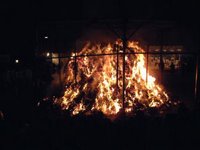The A-Bomb

The A stands of course for Atomic, but for me the A also stands for the Ambiguity I feel with regards towards the dropping of the atomic bomb on Hiroshima and Nagasaki and the representation of history on both the American and Japanese side.
This Tuesday I visited for the second time the Atomic Bomb Museum in Nagasaki. Although I knew what to aspect, I still was blown aback by the pictures of the impact of the bomb on the city, it’s destructing power, the fires that worsened everything after the exploding of the bomb, the survivors, the injuries most likely caused by the radiation.
The museum focuses on the actual bombing and the effect it had on the people. It also has a little section for some of the forgotten victims, the foreign people living in Japan when the atomic bomb was dropped. Especially the fairly large Korean community who under the colonial rule of Japan in Korea had been brought to Japan to work, have been neglected by both the Korean and Japanese government for a long time. Although I can understand that the museum chooses to focus on the actual bombing and the suffering it causes, I do miss the explanation of the historical background of the dropping of the bomb. Because the dropping of the A-bomb is intrinsically linked with Pearl Harbour, the Japanese atrocities committed in Asia during World War II. By neglecting this background it also steps over the question if the dropping bomb was as much a necessity as until now is claimed by the U.S. Government. The museum does give clues that it might not have been as much needed as is claimed. According to an American classmate it is still thought in most High Schools that the dropping of the A-Bomb was necessary to end the war quickly and thereby saving the lives of the soldiers that would be used when the U.S. would do a land invasion, as well as the lives of the people under Japanese occupation, for example working on the Thai-Burma Railroad. There is the conviction that Japan would continue fighting until the bitter end, having the woman and children standing ready with wooden sticks to attack the American soldiers. Another reason is that after the atomic bomb Japan surrendered unconditionally, giving up all it’s colonies, which might not have been case if the atomic bombs had not been dropped. But there are also indications that Japan was on the verge of collapse, being bombed from the air, and virtually being blocked off by a naval blockade. Japan had declined the Potsdam Declaration basically because it asked for unconditionally surrender, and was seeking contact with Russia the only country with which it still had a neutrality pact, to negotiate peace on better terms than unconditionally surrender. Russia declared war with Japan on the same day as the first Atomic bomb was dropped. And according to some the argument for dropping the bomb on Japan, had reasons other than only ending the war quickly, such as paying back Japan for Pearl Harbour, preventing the Russians from occupying Japan, and showing that all the money that had gone to Manhattan Project was not wasted. Unfortunately, the museum also did not provide much information on the reasons for dropping the second atomic bomb on Nagasaki as well as the ultimate surrender by the Japanese.
After the dropping of the A-bomb, the city of Nagasaki focuses on the promoting of peace, Japan got the so called peace constitution, drafted by the U.S. in which Japan was prohibited to have an army. Now more than 50 years later, Japan is the 4th biggest spender on it’s military, although they are still called Self Defence Forces. The ruling party in Japan, the LDP, wants to change article 9, the article in which Japan is denied the right to have an army. On
 e of the main arguments is that Japan wants to be taken serious by other world powers, not only on economic terms but also on military ones. Japan also lives under the threat of possible atomic bombs made in North Korea. And the U.S. are fighting a war against Iraq that they can’t win.
e of the main arguments is that Japan wants to be taken serious by other world powers, not only on economic terms but also on military ones. Japan also lives under the threat of possible atomic bombs made in North Korea. And the U.S. are fighting a war against Iraq that they can’t win.The museum does make you aware of the enormous damage the atomic bomb caused, and that humans should not use this weapon once more against other humans.

